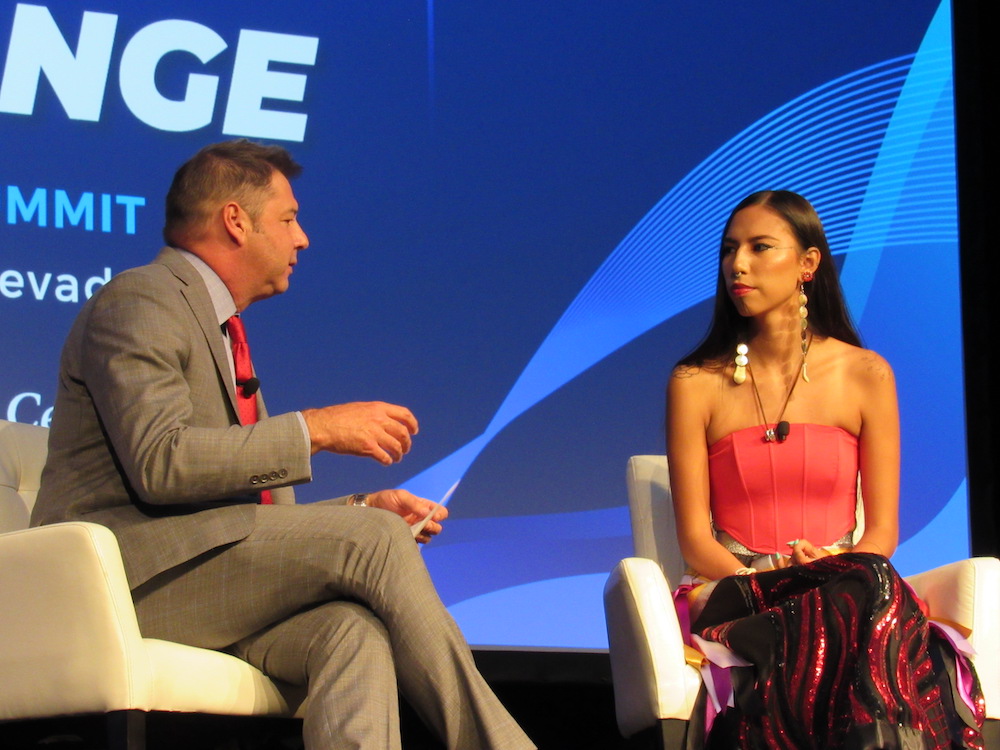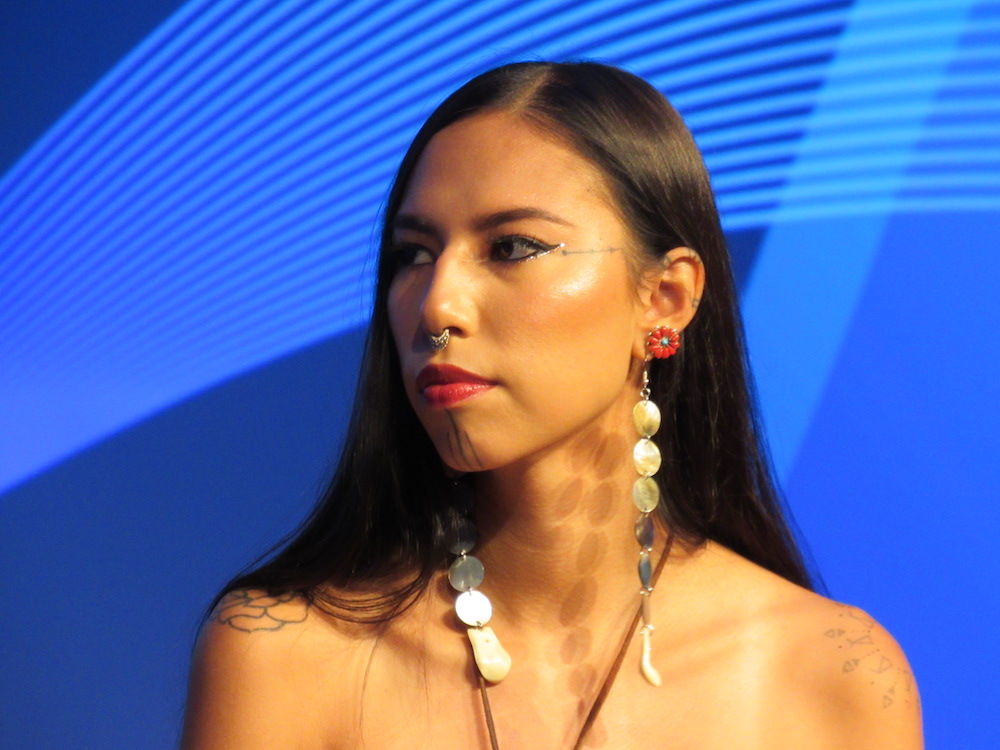
- Details
- By Levi Rickert and Neely Bardwell
LAS VEGAS — Quannah Chasinghorse (Hän Gwich’in and Sicangu Oglala Lakota) made a surprise visit Tuesday to the National Center for American Indian Enterprise Development’s 2022 Reservation Economic Summit (RES), where she was an immediate hit.
The National Center’s President and CEO Chris James sat down to speak with the 20-year-old Native American model, who has appeared on the covers of Elle and Mexico Vogue. Chasinghorse received a standing ovation at the conclusion of her interview.
Native News Online is attending RES and captured this interview with Chasinghorse. This interview has been edited for brevity and clarity.
You definitely have a unique insight into our Native American community. You were born on a Navajo Reservation in Arizona, your parents are Alaska Native and Lakota raised in Alaska. How have you been able to incorporate those elements of all of that?
I think being a model, and this is something new that I think that the modeling industry in every industry is getting used to, is that a lot of models are people of color or BIPOC. Within that community, it's harder for brands and clients to want to change our image, because a lot of the time they want a model that they can change their look. They want you to be able to be a blank canvas for them to play with.
But for me, I am very much a person of, if you want to work with me, you have to work with all of me and that includes my tattoos. You cannot cut or dye my hair, stuff like that—and staying strong with that—because that's how people respect you.
I think it is really good for me to be able to do the work in these spaces and break those barriers. I'm very blessed to be a part of this.
Could you tell us a little bit about (your) youth connection?
Being so young, I think it's so important to show up for my own people in that way. Especially young people, being so young, just showing up and showing each other that we can support each other, we can uplift each other.
We're welcome in every space whether we may feel like it or not. We belong in these spaces, and every space, whether it be modeling, acting, music, academia, like every space we belong, and to never feel like you're alone because at the end of the day, something that really keeps me strong in every space is knowing that my ancestors are with me.
There’s so many beautiful Native designers. Models of so many beautiful people that could easily rise in these spaces, but who just haven’t had the opportunity, or the chance, to show up.

I think now I have a larger platform, but before it was just building relationships in those spaces. One thing I always say is the statistics are out there and the scientists are out there, and it's easily accessible, but what is missing is the experience.
What people don't recognize is that ‘Oh, we know the statistics, we know the facts’, but it's hard to get through to someone without a personal experience or a story to tell. It can be hard to find balance. It can be hard to feel like I'm being seen or heard in these spaces, but I think it's really important to be able to work with the clients and with brands and designers that share the same values and are inspired by our values because that's what creates change.
I have had to have tough conversations with brands and clients where they're not sustainable, and they've had cultural appropriation issues in the past, and now they want to work with me and I tell them 'Well, here's the thing, this is the problem. And this is a problem. This is a problem. And here's how we can fix that. And here's how you can collaborate and here's how you can work with us to be a part of the change.’
That's something I'm really proud of, and I can't really disclose who or what I've done that with so far because it hasn't really come out. But, I'm very proud to say that there have been a lot of changes.
There's this brand called Mackage that I recently did a campaign for, and they were pretty sustainable before, but they weren't fully at a place where I felt they needed to be. They reached out to me, and they wanted to work with me because I've worked with them in the past and they were like ‘We're really really truly inspired by your work and how strong you stand with that and your message.’
So, they created a 100% recycled and upcycled clothing line. I was the center of their campaign. And not only did they do that, but they also allowed me to bring my own Indigenous story and represent that. Just being able to, like I said, work with clients that want to do better and want to be a part of the change and be a part of the movement is so important. To be able to represent my people, not just with my face but with our art, with our jewelry, and that beauty outside of my look, it's an honor, and that's a whole respect dynamic within the industry.
What's next for you? What's next on the horizon?
I have been working on this film for three years. It is called Walking Two Worlds. It's basically my story, but in the beginning, it was all about advocacy. It was when I was doing a bunch of advocacy work before modeling, because my modeling career only started barely over a year ago.
We've been filming this for three years. It was way before any modeling even came up, and it was just about advocacy work. It's about the movement, it's about community, it's about relationships to the land, and the beauty of staying connected and beyond. It shows my growth through the last couple of years and I'm really excited about this because I was really really nervous.
The reason it's called Walking Two Worlds is because, one, I'm in a world where I'm constantly going and going and going in this fast paced high-fashion demanding world that I'm not used to, but I'm still adjusting to. Then, there's the world I'm comfortable in, my culture, my traditions, my way of life, and staying connected to that. Trying to balance the two, I talk a lot about that, and there's a lot of clips in there that show that vulnerability.
There's this one clip where I'm doing an interview, and I'm talking about how next thing you know, I'm in these spaces, I'm in big cities, but then when I go home to the ones that go home to dog-mushing, and go home to traditional foods, to our songs to our political culture, and so I’m trying to find a balance with that.
It's going to premiere at the Tribeca Film Festival. It's about 30-minutes long, and it is in collaboration with the North Face. So, I've been working with the North Face for a few years, and this is their first film that is not around sports, and I'm very honored to be able to be their first film that's about advocacy, and that's about the land because I think working with outdoor industry brands is really important too, because they're the outdoor industry.
We have a lot of folks in the audience that may be wondering “How do I walk in two worlds? How do I work with the business community and focus on my traditional values and my own?”
One thing my mom has always taught me, and something that I carry with me in every space that I go into, and I repeat to myself when I truly need it or I'll even call my mom to get her tell me when I really need to hear it, is ‘Never forget who you are, and where you come from.’
It’s so easy to get distracted in such a capitalist world. It's so easy to kind of lose sight of your values because of this society. This world wasn't built for us. It's not made for people of color.
To be able to be in the place where I am is a blessing and an honor and beyond. Just be proud of your blood lines. Never be ashamed of that.
I used to have self-esteem issues even when I started modeling because being one of the only ones in those spaces and thinking, ‘Why this? Why that?’, and constantly questioning myself. I had to take a moment to recognize that not only have our people come so far we have been through so much for generations, and it's so easy to focus on the hardships, it's so easy to lose track or lose sight of the good things, but you have remind yourself that we also come from so much power.
There's so much power in our bloodlines. We are such powerful people. I think it's easy to forget that because there's so much trauma, so much hurt, that our people go through when it comes to losing our land. Beyond the MMIW epidemic and beyond climate justice there's so many hardships that our people face today. It's so easy to feel small, but remind yourself that we all carry a strong bloodline and that we're still here and we're here for a reason and our ancestors sacrificed so much and to take account of that and never walk in shame.
Help us defend tribal sovereignty.
At Native News Online, our mission is rooted in telling the stories that strengthen sovereignty and uplift Indigenous voices — not just at year’s end, but every single day.
Because of your generosity last year, we were able to keep our reporters on the ground in tribal communities, at national gatherings and in the halls of Congress — covering the issues that matter most to Indian Country: sovereignty, culture, education, health and economic opportunity.
That support sustained us through a tough year in 2025. Now, as we look to the year ahead, we need your help right now to ensure warrior journalism remains strong — reporting that defends tribal sovereignty, amplifies Native truth, and holds power accountable.
 The stakes couldn't be higher. Your support keeps Native voices heard, Native stories told and Native sovereignty defended.
The stakes couldn't be higher. Your support keeps Native voices heard, Native stories told and Native sovereignty defended.
Stand with Warrior Journalism today.
Levi Rickert (Potawatomi), Editor & Publisher
